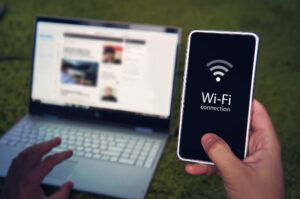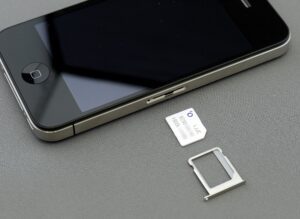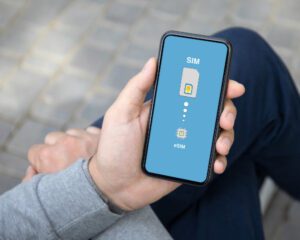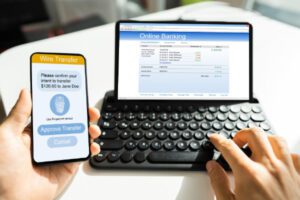READING TIME, 10 MINUTES
It's important to stay connected when you're traveling out of the country. In this post, you'll learn about international phone plans, SIM cards, Wi-Fi apps, and many tips and tricks for using your phone internationally.
Traveling abroad can be so exciting. But staying connected? That can be a bit of a puzzle. There are so many options and lots of unintelligible jargon, you may sometimes feel like you’re swimming in a sea of tech soup.
One option is to bring the grandkids along to figure it all out. The other is to continue bravely diving into this post and walk away feeling like if you can master using your cell phone internationally, you can master anything!
I’m here to help you all the way. Let’s get started.
Terminology Involved in Using Your Cell Phone Internationally
First, let’s define some terms:
International roaming charges
Roaming is when your phone connects to a different carrier than your usual one. When you use your phone outside your home country, including sailing away from port on a cruise ship, your service provider may charge you extra fees. These are called international roaming charges.
These charges can rack up fast, especially if you make a lot of phone calls or use data to browse the internet, send e-mail, and interact with apps like Facebook or Instagram.
Locked phone
A locked phone means that your carrier has added a piece of software to your phone that prevents it from operating on other networks.
For example, if you have an AT&T-locked phone in the United States, you can’t switch your plan to Verizon or vice versa. Many new phones are locked for the contract period unless you pay an additional amount for an unlocked phone.
SIM card
A SIM card (Subscriber Identity Module) is a tiny card inside your cell phone that helps your carrier associate your phone with your account.
This ensures that a call placed to your cell phone number gets to your device and not mine. The SIM card is what lets you make phone calls, access the internet, and send text messages. In most modern phones, the SIM card is removable.
For example, if you change from Verizon to T-Mobile, the T-Mobile store will remove the Verizon SIM card and insert a T-Mobile card. Some phones allow dual SIMs, so you can have two SIM cards installed at once. This is helpful when traveling. I’ll explain more below.
eSIM
An eSIM is a digital version of a SIM card. It does everything a physical SIM card does. If you purchased your phone in the last year or so, it may only have an eSIM, not a physical SIM card.
Two-factor authentication (2FA)
This security method requires two forms of identification to access a website.
You may have seen this when trying to access your bank or credit card. After you've inserted your username and password, you then have to enter a code that was sent to your phone or email.
Wi-Fi hotspot
A Wi-Fi hotspot provides access to the internet at a physical location. For example, you might use a hotspot to browse social media while enjoying a Grande Mocha at Starbucks or when using an internet connection at your hotel.
 Mobile hotspot
Mobile hotspot
A mobile hotspot lets you use your smartphone's data connection to connect your laptop or other portable device to the internet, a process called “tethering.
VPN
A VPN is a virtual private network. It encrypts your data and hides your IP address so you can use public Wi-Fi hotspots safely. It hides your location, so it appears. you're connected to the internetry different from the one you're in.
How to Find Out if Your Mobile Phone Will Work Internationally
To find out if your phone will work while you're out of the country, you'll need to do two things.
1. Check compatibility
Different countries use a different frequency band for each mobile network. Most modern smartphones are equipped to handle multiple bands, but it’s always a good idea to double-check. The countries your phone will work in will be listed on your service provider’s website, or you can pop into the phone store and ask.
2. Check that your phone is unlocked
You need to confirm whether or not your phone is unlocked and can be used internationally.
Here’s how:
- iPhone: Go to Settings > General > About. Scroll down to the section called Service Provider Lock, or Carrier Lock. If your phone is unlocked, it will say, “No SIM restrictions.” If you don’t see this message, contact your carrier and ask to have your phone unlocked.
- Other phones: If you purchased your phone directly from Google, it’s unlocked. You should check with your carrier if you purchased it elsewhere or have a phone from Samsung or another manufacturer.
Most service providers will unlock your phone if you’ve fulfilled your service contract. In other cases, you can pay a fee to have your plan terminated early.
If you’re thinking about traveling in the future and it’s time to buy a new phone, purchase one that is already unlocked. It may cost a little more, but you’ll at least be able to use your phone.
If you can’t have your phone unlocked, you have two choices.
- You can wait until you have free Wi-Fi for cellular data, or you can purchase an inexpensive unlocked phone at your location, one that has Wi-Fi hotspot capabilities.
- You can then use Wi-Fi hotspot tethering on that phone to provide access to data for your main phone. Here's how you do this on an iPhone, and here's how on an Android.
Phone Options for Traveling Internationally
Phone Options for Traveling Internationally
Which option or options you select depends on where you're going and how long you’ll be gone, the type of phone you have, and the international plans offered by your service provider.
Let’s look at the options:
Use an International Plan with Your Current Carrier
When you use your current plan outside your home country, you may be charged fees for “roaming.” Roaming occurs when your existing phone connects to a new carrier overseas.
For example, if you arrive in Ireland with data roaming enabled on your phone, your phone will likely connect to the network there, and you can continue to use it as you do at home.
 However, you will pay more when you roam than you pay when you use your phone at home, often a staggering amount more. So, one good option is to purchase an international plan from your current carrier.
However, you will pay more when you roam than you pay when you use your phone at home, often a staggering amount more. So, one good option is to purchase an international plan from your current carrier.
Some plans, like those with T-Mobile, Google Fi Wireless, and others, provide some limited voice calls and data allowances. Verizon and others have free talk and text if you’re traveling in North America, and AT&T and others offer International Day Passes.
Advantages of an international plan
There are some definite advantages to purchasing an international travel plan from your current carrier.
- You’ll know the cost. You sign up for a set amount of data, texts, and minutes, so you’ll know exactly what you’ll pay, and there won't be any unexpected charges.
- It’s convenient. You don’t need to fuss with any SIM cards or figure out how an eSIM works.
- You keep your U.S. number. This helps you make sure you won’t miss any calls from home and allows you to use two-factor authentication on sites that require it.
This is the easiest option for international travelers but is usually the most expensive because you're paying to access foreign networks. But if you're on a short trip and don't use your phone often, it may be worth a slight extra cost.
Disadvantages of an international plan
- If you go over your purchased amount, roaming charges can add up quickly unless you purchase another plan.
- Some countries may charge additional roaming fees.
- To keep charges down, you'll need to put your phone in Airplane Mode unless you have Wi-Fi available.
The best way to make a decision about how to use your phone for international travel is to start by investigating international roaming charges for talk, text, and data with your current service provider. Then, you can compare the cost with some of the other alternatives below.
If you've decided to purchase an international data plan from your local carrier, you can skip the next two sections and go directly to the section, Phone Home Over Wi-Fi.
Purchase or Rent an Inexpensive Phone
If you don’t consider yourself a digital nomad and you won’t be using your phone that much, a practical and cost-effective option is to buy an inexpensive flip phone to use while you're gone.
You can often find these phones for rent, too, although you then have the hassle of returning it to the location where you rented it.
Purchase a SIM Card and Mobile Data Plan
If your phone has a removable SIM card, you can purchase a new one at your destination. Most modern phones have either a removable SIM card or a digital SIM.

Photo by Brett Jordan on Unsplash
To find out if yours is removable, look for a little slot on the side of your phone. Most are only about 1/2" long, although some are a bit larger. It will have a tiny hole in it.
There are two types of SIM cards:
International SIM Cards
An international SIM card can be used across countries. For example, if you're traveling to several countries in Europe, look for one SIM card that covers multiple countries.
For you round-the-world travelers, I've seen SIM cards that cover up to 200 countries and territories.
You can often buy International SIM cards before you leave home.
Local SIM Card
A local SIM card can be only be used in one geographic location. You purchase these at your destination.
For example, if you visit New Zealand, you buy and install a local SIM card to use in New Zealand. If you then fly to Australia, you'll need to purchase and install a new local SIM card there.
How to Purchase and Activate a Physical SIM Card
1. Purchase the SIM card
Carriers are often right in the arrivals lounge and are happy to sell you a card. You can also usually purchase one at a phone store, the supermarket, or a convenience store.
Do some research before you go, though, so you know ahead of time which SIM card plan will work best for you while you're away from home. Consider how many calls you make, how many texts, and how much data in an average month. Then, estimate how much you'll need when you're traveling.
Choose a plan based on your data usage. You may want to limit the data you use, or you might want to purchase unlimited data. The same goes for calls and texting.
Also, be sure whichever provider you choose has support in a language you speak.
2. Install the SIM card
Here’s a video showing how easy it is to switch out your SIM card.
Be sure to keep your old card safe, as you’ll need to pop it in again to use your phone when you’re back in your home country.
If you accidentally lose your SIM card, your carrier at home can help you get your phone working again once you return, but it will take time.
A better option is to just be safe. When we had phones with physical SIMs, we would tape our SIM card to a business card and put it in our wallet. That way, it wasn't so easy to lose or damage the tiny little thing.
3. Activate your SIM card.
Follow the carrier's activation steps. You may need to show some form of ID to do so, so don’t be surprised if you’re asked for your passport.
I suggest activating your SIM card before you leave the airport. That way, the person who sold it to you can help in case you have any problems.
Advantages of a SIM card
- A SIM card is less expensive than paying your current carrier for roaming.
- You can tailor data limits and call/text benefits to your needs or get unlimited calls, texts, and data.
- Providers often have prepaid options, so you don’t have to sign a contract
- International SIM cards can be purchased before you leave the US, so you’ll be connected immediately when you reach your destination.
Disadvantages of a SIM card
- You can’t try it until you get to your location where you can connect to that cellular network. So if there’s a problem, you’ll need to solve it while traveling.
- You can’t keep your U.S. phone number. Instead, you’ll get a new local phone number. That means your friends and family back in the US will incur charges for an international call if they want to contact you on your new number.
- Unless you have a phone that supports dual SIM cards, you’ll need to insert and remove SIM cards to check your phone calls from home.
If you think a SIM card will be the best option for you, here are the instructions for removing your SIM card and inserting a new one if you have an Android phone, and here are the instructions for an iPhone.
What if your phone has dual SIM slots?
If your phone has dual SIM slots, you need to configure each card and keep track of which card you’re using. Be sure to turn off roaming and mobile data on the card you’re not using at the moment. You do this in Settings.
Also note that having two SIM cards can also drain your battery more quickly.
Purchase an eSIM for Your International Trip
 An eSIM is a digital SIM card embedded in your phone when it’s manufactured. There’s nothing to remove, so nothing to lose. It identifies you as a subscriber and connects you to the carrier’s network, just like a physical SIM.
An eSIM is a digital SIM card embedded in your phone when it’s manufactured. There’s nothing to remove, so nothing to lose. It identifies you as a subscriber and connects you to the carrier’s network, just like a physical SIM.
How to determine if your phone has an eSIM
The first thing to do is confirm that your phone is compatible with an eSIM.
- iPhone: Go to Settings > General > About. Scroll down to Available SIM, ESIM, or Digital SIM. If your phone has a 15-digit IMEI number, it supports Digital SIM. If not, you’ll need to buy a physical SIM card or purchase a data plan from your existing provider.
- Other phones: Various other phones work differently, so unfortunately, I can’t give you exact directions. You can look up your phone's specifications online or check with your reseller or carrier.
How to purchase and activate an eSIM
1. Purchase an eSIM plan
Decide if you need voice and data or data only. For short trips, you can get a pre-paid card. The price is based on how many gigabytes (GB) you need and for how long. If you'll be gone for an extended period, look for a vendor that offers monthly plans and see if that will save you money.
To figure out how much data you'll need, check your latest few phone bills to see how many GB of data you use each month, then decide if you’ll be using more or less data while you’re gone.
Airalo and Holafly are two contenders for international travel. And there are many smaller companies, which you can find by searching for “Best eSIM for _____ country).
2. Activate the eSIM
To activate your eSIM, you’ll use a QR code or an app, depending on the provider. Instructions will be on the website where you purchased your eSIM. Once you activate your eSIM, you'll have a local number.
Advantages of an eSIM
- There’s no SIM card to lose.
- You can toggle on and off between your home plan and your eSIM in your phone’s Settings. No more popping SIM cards in and out.
- You aren’t tied to a particular carrier and can switch your plan as you travel.
- You can use a physical SIM and an eSIM at the same time. So if you already have a physical SIM card for home, you can continue to use that while you’re traveling, either with a data roaming plan or if you'll only need your phone in case of an emergency, you can just pay the extra roaming fee
- Depending on your phone, you can install more than one eSIM. For example, my iPhone supports eight eSIMS, so if I traveled frequently between New Zealand and Spain with a stopover in Dubai, I could have three local eSIMS that I could turn on and off as needed. Or I could purchase one international eSIM.
- You can activate two eSIMS at the same time, so you can use two phone numbers. That means you can use different providers for different things.
The settings section on your phone lets you choose which is your primary number, which phone to use to make calls, and which to use for text and data.
Disadvantages of an eSIM
- If your phone stops working and you have a physical SIM, you can remove that card, place it in a new card, and be back in business. You can’t do this with an eSIM as there is no card to remove.
- Although hundreds of carriers worldwide support eSIMS, not all do yet. This list of wireless carriers that support eSIMs provides a starting point.
- It’s a little more difficult to set up an e-SIM than simply popping in a new SIM card. But you can do it if you just slowly follow the directions. I know you can!
Phone Home Over Wi-Fi
 If you want to stay in contact with the folks back home but don't want to purchase a voice plan when you're on an international trip, the cheapest way to do that is to make free voice or video calls with a Wi-Fi communication app.
If you want to stay in contact with the folks back home but don't want to purchase a voice plan when you're on an international trip, the cheapest way to do that is to make free voice or video calls with a Wi-Fi communication app.
To use Facebook, open a conversation with the person you want to call, tap the three dots on the right to open the menu, and select Audio or Video Call.
Messenger
To make a call in Messenger, click the "Open Profile” button, then follow the instructions for Facebook above.
- iPhone
If you have an iPhone, here's how to make a voice call on WhatsApp, and here’s how to make a video call. - Other phone:
If you have another phone or want to use your desktop, click the appropriate link at the top of one of the pages with instructions for the iPhone.
Skype
Skype is another way to make free voice and video calls.
Unlike the services above, where you can only call people you're connected to and who are online at the time, with Skype, you can also make calls to people who are not using Skype, although there will be a small international charge.
You can learn more about Skype here, and then download it from the App Store or Google Play if you think it will be the best option for you.
Advantages of Wi-Fi communication apps
- You can make audio or video calls using free WiFi
- These apps are pretty straightforward to use
Disadvantages of Wi-Fi communication apps
Unless you’re using Skype:
- The people you’re calling need to be friends or contacts already.
- You both have to be connected to the internet and have the same app installed on your device.
- You can’t place calls to landlines and cell phones, only app-to-app.
Caution! What About Two-Factor Authentication (2FA) When Traveling Internationally
Picture this: You're on vacation in Spain, and you want to log in to your credit card account and make a payment that's due tomorrow.
 The bank needs to send a code to your phone for you to enter on their website. But with your SIM card installed, you're running on the local network with a different phone number, so you can't receive the code. Now what?
The bank needs to send a code to your phone for you to enter on their website. But with your SIM card installed, you're running on the local network with a different phone number, so you can't receive the code. Now what?
Panic! That’s what.
Here’s how to get prepared ahead of time so you can seamlessly access the information you need while you're gone.
2FA if you have an international roaming plan with your current carrier
If you purchased an international phone plan, you’ll have access to the website the same way you would at home.
However, many places, like some banks, Medicare, and the Social Security Administration, can tell you're out of the country and won't give you access. To get around this, you need to use a VPN.
This is an app you download and then connect to a network in the U.S. It will then look to the bank or SSA, like you're in the U.S., and they'll give you access so you can log in. We use ExpressVPN.
If you're using an international roaming plan, you can skip the next section) and go to What Else Do You Need to Do to Use Your Phone Internationally.
2FA if you’re using a local or international SIM card or eSIM
If you’re not using your home carrier and are instead using a SIM card, here are some options for you.
- Request the code be sent via email if that's one of the choices.
- Find out if you can receive push notifications in the institution's app. As long as you've used this device for 2FA before you leave, and you don't reset your phone or clear your saved data while you're gone, you should be able to authenticate your login in the app.
- See if you can use an authenticator app like Authy, Microsoft Authenticator, or Google Authenticator. These authenticators don’t require a mobile signal. Some institutions have this available, but others don’t.
- Use your home SIM. If you have two SIM cards in your phone or an eSIM, this won't be a problem. You just need to turn on mobile data for your home SIM card in Settings to receive the code and continue your transaction. Be sure to turn it off once you’ve completed your transaction though, so you don't incur additional charges.
- Switch out your SIM cards. If you only have one SIM card, remove the local SIM card, pop in your one from home, and take care of your business. Again, be sure to swap the cards back out as soon as you're done. This will incur charges, but at least you'll have access to the information you need.
- Call your bank. This may also cost, depending on which plan you've purchased for your SIM card, but you should be able to verify your identity verbally.
If you want to access these types of accounts when you're traveling, set 2FA up the way you want before you leave. Be sure your banking profile is up to date with the correct phone number and email address where you can receive notifications. If possible, switch to using in-app authentication or an authenticator app.
If you want to file all this in the "too hard" bucket, call your bank and see if they'll temporarily remove 2FA. If they agree, be sure to make a note to turn it back on when you return home. This is not the safest option since 2FA is there to protect you from unauthorized access, but at least you’ll have access to what you need while you’re gone.
What Else Do You Need to Do to Use Your Phone Internationally?
OK…you’ve got your data plan figured out. What else do you need to do to be able to use your phone while you’re out of your home country?
- Preload apps that work offline.
For example, you can use Google Maps to download a map of your destination country. You can then navigate without an internet connection and save on data charges.Here's how to do this on an Android phone, and here's how if you have an iPhone. If you’re going somewhere where you need help with language, you can download Google Translate.
- Turn off any automatic downloads for your apps.
That way, if you switch off airplane mode, you won't be using data unless you intend to. You can always update apps manually if you need to. - Change your email so you have to fetch it
Be sure it's not set to download automatically. Just look at your email when you have free Wi-Fi - Back up your phone
- Disable Bluetooth Wi-Fi if not needed to save battery life
- Get a good case and insurance
- Know where your airplane mode switch is.
If you're not using your phone, keep it in airplane mode. This will be the safest way to avoid accidental roaming charges.
Final Words
Congratulations! You've learned how to use your phone to stay connected when traveling internationally and how to avoid nasty surprises on your phone bill.
Your choice of the best plan will depend on the type of SIM card your phone has, the mobile service you’re currently using, where you’re going, and how many calls, texts, and data you’ll need.
‼️ I suggest you save a link to this post or pin it on Pinterest in case you need to refer back to it as you learn more about the options available to you.
And be sure to share this with your traveling friends who may need a little help sorting this all out.
✳️ Here are some other posts to help you on your travels.
What Travel Documents Do You Need for an International Trip?
Avoid Pickpockets Like a Pro: Tips for a Safe Vacation
Pin this post for later!


Definitely will check this out as have a trip Europe later this year!
Awesome! Have a great trip.
This complete guide on using your phone internationally is incredibly helpful! The tips and tricks you’ve shared make it so much easier to stay connected while traveling. Thank you for providing such clear and practical advice!
You’re welcome, Catherine. Glad it was helpful.
I learned a ton from this post! When I went to Italy, I bought an AT&T international plan. That was several years ago.
Hi Susan. I used to purchase plans too, but since I’m traveling so much at the moment, I use an eSIM I just turn on and off. However, international plans can totally work…it just depends on how long you’ll be gone, the cost of of the plan relative to others, etc.